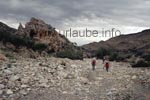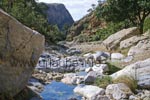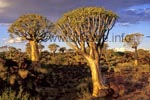Travel destinations in the south of Namibia

The south of nmibia is extremely sparsely populated but it has some fascinating sightseeings in the landscape as for example the Fish River Canyon as the second biggest of the world and the quiver tree forest at Keetmannshoop. For those who drive by themselves, it will be an unforgettable experience due to the wideness and the devoid of people of this area.
The guest farm Ababis
The guest farm Ababis is located at approximately 250 km at the south of Windhoek not far from the Namib Naukluft park. The farm that is managed by the german couple Schulze-Neuhoff was priced several times as the best guest house of Namibia. Rightly, as we think, as the whole complex with the attractive buildings in the colonial style offers a good mix of elegance and a convenient style. Additionally, there is the hospitality of the owners and the good cuisine. In the evenings, the guests and the hosts sit together to have dinner and talk about "all the world and his wife".

Elsewise, it is never boring here, as the programes in offer are very diversified from guided tours and the intermediation of sightseeing flights up to the off-road-training with 4x4 all-terrain vehicles in the trainig centre that was opened in the year 2004; Within the complex of the farm there are a lot of hiking paths as also a nature studies path alongside a dried river bed. After that, one knows a lot more about the nature of Namibia. After finishing this nature studies path we were full of beans and also explored the river bed by ourselves. But this should not be done during the rain season, as the rainfalls are certainly seldom but also extremely strong and within shortest time, the river bed that was peaceful and dry converts to a rushing torrent. The offered farm trip is also recommendable on which the hosts inform one about many vwery interesting details of the life in Namibia.

A guided tour through the surroundings leads to the rock paintings of the San, the aboriginal people. On the way to there we meet Maria and Joseph. No, not the ones from the bible. Maria and Joseph are employees of the neighbour farm of Ababis, black and Namas. Here, it gets clear that Namibia has been a German colony; The black worker's names are Wilhelm, Fritz, Auguste and, as mentioned, Maria and Joseph. We are greeted by everybody in a very friendly way and as per our wish, the whole family proudly poses in front of the camera.
The trip to the rock where the stone-age paintings of the San are visible leads through a very attractive hilly savannah landscape. Once arrived there, we are a little disppointed, as there are barely four to five quite inconspicuous wall paintings. Those who know the rock drawings and gravings of Twyfelfontein will only weary smile. But the picknick and the more attractive drive back in the evening light are fully compensating. In any case we did not regret this tour.
The guest farm Büllsport
At a distance of approximately 45 km from Ababis, thus for Namibian conditions in the right proximity, there is the guest farm Büllsport, one of the oldest guest farms of Namibia. Also in this farm there is a lot offered to the guests. Some riding excursions can be booked, hiking tours can be made or one can simply relax in the garden of the farm at the big swimming pool. In the in-house library one finds some literature. The farm even has an own gas station that is also open for the visitors; A worker pumps the petrol by means of a handwheel and is of course very happy by getting a small tip. As it is almost always the case in Namibia, the accommodations are very good and the cuisine excellent.

The quiver tree canyon is a relatively unknown treasure and our insider tip for the guests of the Büllsport farm that is located in this complex; People can have a hiking tour there provided they book such a tour. With some all-wheel-drive vehicles we drive up to the Naukluft plateau over some steep and narrow paths and from there, one continues on one's own on a hiking tour up to the quiver tree canyon. At the end of the tour of approximately 5 hours, one is caught up by the driver and brought back to the farm. The hiking stretch is perfectly signposted so that one cannot miss the way.

A fabulous landscape and an abundant flora offer an experience to the nature lovers that should not be missed. At the ground of the canyon, a brook flows. It flows over some washed-out stones which colours change from toned white to brown-red and blue-green, forms some courses with abundantly grown shores, small ponds and cascades, also deep water holes that completely fill the ground of the canyon and flows at the end to a huge embedded rock cylinder in order to continue a subterranian way. The fountain flows all over the year and its water provides the conditions for such an abundant vegetation, amongst other the quiver trees that give the canyon its name and the diversified fauna.

Fortunately, this treasure of the nature is left by the owners of the farm mainly in its original state. There are some inevitable marcations and climbing supports at the canyon walls, but no paths or bridges. This tour is, without doubt, an exhausting excursion and during the midday heat we were pushed to our physical limits. Important is to cope the natural obstacles in an adventurous way and, among other things, to climb up the steep walls of the canyon and get back after avoiding the water hole. Anyway: we recommend everybody coming to Büllsport not to miss hiking through the quiver tree canyon. At the end, we were totally enthusiastic of the maybe most beautiful natural experiences we ever had but we also were totally exhausted; Reason: neither we are professional athlets nor we are young. But also young tourists should be ready for an exhausting tour.
In Büllsport, also tours to Sossusvlei are offered. This is surely a possibility to experience the Namib desert. But personally, we think that this would make more sense if done from an accommodation right at the park of Sossusvlei or at least from a shorter distance. In the end, everyone has to decide for themselves.
Canon-Lodge, Fish River Canyon
The Fish River Canyon belongs to the most outstanding sightseeings of Namibia and it can be even said on a worldwide level. It is the second biggest of the world after the Grand Canyon in the US. Compared with its length of 165 km, width of 30 km and depth up to 500 m, the human being seems to have the size of an ant. A hiking tour alongside these canyons belongs to one of the most impressive experiences one can ever have.

We booked the canon-lodge at the Fish-River-Canyon and can only recommend it to every tourist visiting Namibia. Four Namibians founded it in the complex of several sheep farms in the Gondwana-nature-park that were given up as they were not rentable any more. In this natural protected area that is also opened from the sunrise up to the sunset, it is tried since several years to make the original flora and fauna native again. This is also the reason why this lodge belongs to the most attractive and adventurous ones of Namibia. The accommodations, some small houses made of natural stones, are partly built into the rocks and from each one, one has a wonderful view to the very attractive landscape. Either in the winter time as also in the summer, these huts were always very pleasantly air conditioned. Those who walk alongside the curvy paths between the huts will notice that there are also some other guests. Dozens of dassies bustle between the rocks and over the roofs of the huts.

Those who have enough time can choose one of the variated offer of activities: sunset- and sunrise-tours, guided hiking tours, flights over the canyon, riding and more. One should not miss the climbing of the local mountain that is offered every afternoon. It is free of charge for the guests of the lodge and apart from chilled drinks, one has a wonderful view to the surroundings in the sunset light. Despite of all justified lauds to the canon-lodge, the actual sightseeing is still the Fish River Canyon itself.

In the Gondwana Nature Park a road leads to two main view points from which one has an excellent view over the canyon. But we found the views from a path at the edge of the canyon more impressive, almost sublime. Therefore, one should already plan a couple of hours. This time is worthwhile in any case. There are a lot of kilometres so that it makes sense to take the car. In this path, it is possible to get ahead for a big distance in a normal car, but after approximately 15 km it is only possible to continue with an all-wheel-drive. But these first 15 km also provide some fascinating views.
For extreme sport athlets, a hiking tour through the canyon is offered, a tour that takes four to five days, provided one has an excellent fitness, enough training and a current health certificate not older than 40 days. Those who have all this should anyway book the tour minimum a year in advance. Any time, only a few participants are accepted and from October up to April, no tours are possible in the canyon due to the extreme heat and the flood danger.
In Ai-Ais one can make a day excursion. In the language of the Nama this means "The place that is very hot". In this green oasis of the otherwise scant landscape of the Fish River Canyon, some fountains flow with a water heated up to 60 degrees, a thing that is supposed to be very helpful in case of rheumatic complaints. An indoor swimming pool, some whirlpools and an outdoor swimming pool provide an experience that is actually not typical for Namibia. but Ai-Ais is only opened from mid of March up to the end of October due to the big heat and the flood danger.
Keetmannshoop
With approximately 15.000 inhabitants, Keetmannshoop is a big city for Namibian standards, is located at the south of the country and still presents some clear traces of the German influence of the past. By this way, one finds the "Kaiserliche Postamt" (Imperial Post Office) that today is the tourist information centre.
What is also worthwhile seeing is the museum of the evangelic-lutheran church. Thereby, the pulpit of the church is also very interesting. In former times, the church services took place under a big camel-thorn tree. The church was simply built around the tree and the pulpit was carved from it.
Those who visit Keetmannshoop will not avoid to enter "Uschis Kaffeestube" (Uschi's coffee shop) and enjoy a Schwarzwälder Kirschtorte (Black Forest gateau)or Quarkkuchen (cheesecake). Keetmannshoop is also one of the few places of Namibia where there is a public internet shop and a mobile radio connection.

But the most important sightseeings are outside. Approximately 15 km at the north-east at the road to Koes, there is the quiver tree forest. Despite of their names, quiver trees are not trees but aloes that grow up to 8m. They only occasionally appear in the south of Namibia and in the northern Cape region. But in Keetmannshoop, in the complex of the farm Gariganus, there are approximately 300 of this worthwhile seeing plants on an own space and therewith really appear to be a forest. The owner of this farm of course takes advantage of this speciality and takes an entrance fee for vieweing it. But it is moderated and should not be deterring to anybody. Specially during the sunset, the curious shapes of the quiver trees offer an impressive view.
By looking at the tumbled trees it is possible to see that these plants are real shallow rooted that clinge to the stones and rocks. Their trunks are as light as cork, and this is why we can confidently say that we have lifted such a trunk "blindfold". The quiver trees got their name from the San, who carved their arrows from its branches.
In this farm, it is also possible to get accommodated in the Quivertree Forest Camp so that there is enough time for the sightseeings of the surroundings and that one can also enjoy a sunset in the quiver tree forest.

In the camp, it was recommended to us to keep the door of the accommodation always closed. The reason for this became clear to us when we were, suddenly, standing "eye to eye" in front of a warthog, the "mascot" of the camp. It loves to visit the accommodations that some careless guests left open - and afterwards, it really looks messy there. There are also meerkats bustling around everywhere in the complex, these cute mates are relatively docile, so that they can be observed from the proximity.
The speciality of the Quivertree Forest Camp is the cheetah husbandry. Those who are brave enough can get into the enclosure in order to have a close look to the cats of prey. It really is an excellent experience, as one does not come across to a cheetah every day and specially not with such a proximity.
There is another sightseeing in the complex of the farm, the "playground of the giants". It offers a loop road through some giant rocks that are partly towered, partly edged, and partly weathered round of a red-brown colour that occasionally form some walls and seem to be carelessly thrown down elsewhere. Their name is matching. One could really think that the giant of the fairy tale has been playing here around with the rocks, towered them artfully and, once bored, thrown them away afterwards.
The semi desert Kalahari
The Kalahari, a semi desert that extents over approximately 1,2 million km² over some large parts of Botswana, South Africa, Angola, Sambia and the east of Namibia, does not offer - at least in the Namibian part - those breathtaking touristical highlights of the Namib desert but therefore the opportunity of very unusual observations of the animals in their natural surroundings. These are also the focus points of the farm trips and excursions.

What is offered there can be hardly compared with such attractions as of the south African Krüger Nationalpark or the Etoscha Park in the north of Namibia. The animals do not permanently come across to the visitor. But with a little luck, one can see in the Kalahari apart from the abundant springboks and ostrichs also wildebeests, zebras and giraffes. Watching their often strange behaviour to us with the own eyes from a relatively short distance is one of the most unique experiences of a trip to Africa.
As this area otherwise offers less sightseeings than the other areas of namibia, most of the tourists use the guest farms and lodges as accommodation for one night only. Then it is of course specially important to arrive relatively in time in order not to miss the animal viewing.

Our first stage destination alongside the Kalahari was the Auob lodge. In relation to most of the other lodges and guests farms, the Auob lodge is, according to our opinion, of a little lower standard of level; Either the accommodation, the cuisine and also the service could not compete with what we had previously experienced. Here, one certainly also gets some quality offered, but one is soon spoiled and sets the standards of the other accommodations. But this was compensated by the farm trip, in which it was specially looked after some giraffe herds in the complex. We had been lucky and could get at a distance of only a few metres to this imposing animals.
The bitterwater lodge was a speciality of this area and the destination of our second stage. A big gliding flight centre belongs to the lodge in which there are competitions two times a year. In the foreseeable future, it is supposed to offer the possibility to make some gliding flights over the desert as a passenger. Interestingly, the gliding flights provided the lodge several palm boulevards. This is related to the tradition: every glider who did more than 1000 km plants a palm; if more than 2000 km are done, a king palm.
In this lodge it is also done a lot for the well-being of the guest; Apart from a comprehensive library and some diversified games there are several telescopes. Watching the African evening and night sky is breathtaking for the Europeans. Used to the haze domes above the industrial city, we gaze at the zodiac signs of the solar system known to us n a clearness never experienced before - again, an experience for which one has to come to Africa.

Back to the index Namibia
Author: Michael Nitzschke, Copyright: Patrick Wagner, www.tourist-guide.biz
|